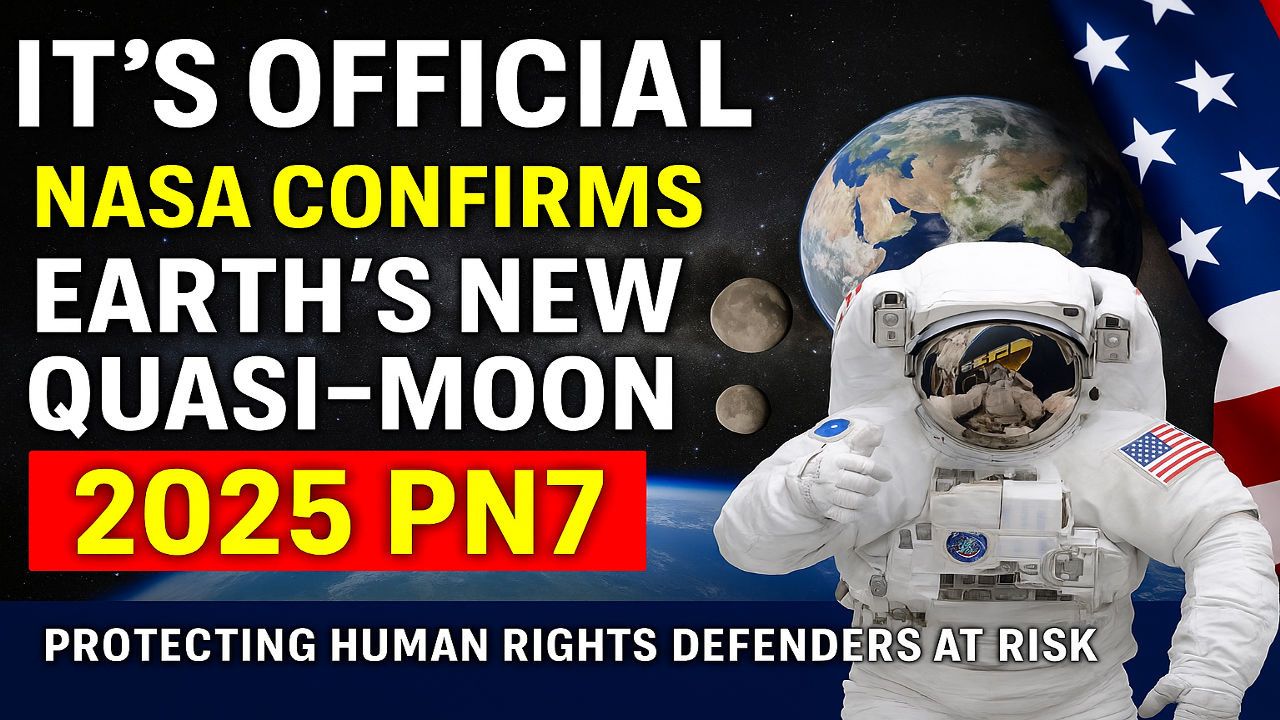Earth’s night sky just got a little more interesting. NASA has confirmed that a building sized asteroid, cataloged as 2025 PN7, is traveling in near lockstep with our planet. It is not a second natural satellite like the Moon, it is a quasi moon that orbits the Sun and keeps pace with Earth for years at a time. Below is a clear explanation of what that means, how 2025 PN7 behaves, what makes it special, and how you can follow official updates.
Table of Contents
NASA Confirms Earth’s New Quasi Moon 2025 Quick summary

Item |
Details |
|---|---|
Object |
2025 PN7, a small asteroid classified as a quasi moon of Earth |
Estimated size |
Roughly 18 to 36 meters across, comparable to a small building |
Path |
Orbits the Sun while staying in a gravitational dance with Earth, near one to one resonance |
Typical distance |
About 4 million to 17 million kilometers from Earth during its loop |
Likely companion period |
Roughly the last six decades, with departure from the current configuration expected around the 2080s based on modeling |
Risk to Earth |
No known impact risk from the reported trajectory, object is in a solar orbit that only loosely couples to Earth |
Why it matters |
Refines models of small body dynamics, improves tracking of near Earth objects, offers potential testbed for future proximity missions |
Official site |
What exactly is a quasi moon
A quasi moon is a solar orbiting object that remains in a long lived gravitational relationship with a planet. Unlike a true moon, which is captured by and orbits the planet itself, a quasi moon moves around the Sun but maintains a near match with the planet orbital period. From Earth’s point of view this can look like the object is looping around us. In reality the asteroid traces a complex horseshoe or tadpole shaped path in a frame of reference that rotates with Earth.
This configuration happens when the Sun gravity dominates the motion and the planet provides a smaller but persistent tug. The result is a slow relative drift that can keep the object near the planet for years or decades. Quasi moons are uncommon. Only a small number have been confirmed for Earth, and each new case gives scientists another dataset to test the three body dynamics that govern these graceful dances.
How 2025 PN7 moves
2025 PN7 appears to share almost exactly the same orbital period as Earth, close to one year around the Sun. Because its orbit is slightly different in shape and tilt, the asteroid alternately lags and leads Earth over time. In a rotating frame the path resembles a bean shaped loop that encloses a point near Earth’s orbit. The object distance varies significantly during each cycle. At its closest approach the asteroid can be on the order of 4 million kilometers from Earth. At its farthest it can be near 17 million kilometers. For perspective, our Moon averages about 384,400 kilometers away, so 2025 PN7 is many times farther than the Moon even at its nearest swing.
This near resonance is stable but temporary. Subtle gravitational nudges from Earth, the Sun, and to a lesser degree Venus and Jupiter, gradually change the path. Dynamical models indicate that 2025 PN7 began its current near Earth companionship roughly six decades ago and that it will eventually drift out of this configuration in the 2080s, returning to a more ordinary near Earth asteroid path that no longer loops around us in the same way.
Size, brightness, and visibility
With an estimated diameter between about 18 and 36 meters, 2025 PN7 is small even by asteroid standards. Objects this size are very dim. They require wide field survey telescopes to spot and continued follow up to refine their orbits. The brightness also changes with distance and the angle at which sunlight reflects from the surface. That is why professional surveys and radar where available are central to tracking accuracy, and why positions and uncertainties improve as more observations are added.
Why the discovery matters
- Better models of orbital mechanics
Quasi moons push our understanding of three body interactions. Each one gives researchers a real world case to test long term stability and resonance capture models that are hard to replicate in a laboratory. - Improved planetary defense
Every precisely tracked near Earth object strengthens orbit determination techniques, error analysis, and follow up strategies. Even low risk objects contribute to better software and survey practices that help identify any future hazards more quickly. - Future mission concepts
Quasi moons are relatively nearby and have low relative speeds at certain points in their loops. That combination could make them suitable for technology demonstrations in autonomous navigation, small body sampling, in situ resource characterization, or long duration proximity operations without the fuel demands of deep space targets. - Public engagement in small body science
Objects like 2025 PN7 capture public imagination and provide an approachable entry point to discuss gravity, resonance, and how scientists transform faint telescope dots into confident trajectory forecasts.
Is there any danger to Earth
There is no known impact risk from the current solutions for 2025 PN7. The asteroid follows the Sun and simply remains near Earth’s track. Distances of millions of kilometers provide a very comfortable buffer. As with all small bodies, astronomers will continue refining its path as new observations arrive, reducing uncertainties and keeping the catalog up to date.
How long will 2025 PN7 stay with us
Current modeling suggests that the object has been loosely bound to Earth’s neighborhood for about sixty years and will depart its quasi moon state in the 2080s. The exact timing depends on tiny accelerations introduced by planetary encounters and solar radiation effects. This is normal for small bodies. Their orbital histories are probabilistic envelopes that tighten with added data.
How to follow official updates
For authoritative mission and discovery notes, as well as background on near Earth objects and observation campaigns, use the official NASA portal:
- NASA: www.nasa.gov
You can also look out for updates from professional surveys and observatories as they publish new measurements that refine the orbital elements.
Frequently asked questions
1) Is 2025 PN7 Earth’s second Moon
No. It is not a bound satellite of Earth. It is a quasi moon, which means it orbits the Sun while staying in a long lived gravitational dance with Earth. Our planet still has one true natural satellite, the Moon.
2) How close does 2025 PN7 get to Earth
Typical modeled distances range from about 4 million kilometers at the nearest part of the loop to about 17 million kilometers at the farthest. That is far outside the orbit of the Moon.
3) Can I see 2025 PN7 with a backyard telescope
Unlikely. The object is small and faint. It is primarily the province of professional surveys with large apertures and sensitive detectors.
4) How certain are scientists about the orbit
Uncertainties shrink as more observations accumulate. The quasi moon classification depends on the object orbital period and geometry relative to Earth. Continued tracking will keep refining the solution and the expected departure timeframe.
5) Could quasi moons be mission targets
Yes. Their relative proximity and predictable motion make them attractive for small spacecraft demonstrations, sampling technology, and navigation tests. Mission feasibility depends on launch windows, delta v, and surface properties that are still being characterized.
Bottom line
2025 PN7 is a small but scientifically significant neighbor. It does not circle Earth like the Moon, yet it keeps pace with our planet in a graceful, temporary resonance around the Sun. The discovery adds a new case study to the short list of confirmed quasi moons, sharpens our understanding of small body dynamics, and hints at future mission possibilities close to home. Track official updates through NASA, and watch as astronomers continue to refine what we know about this quiet companion in our shared orbit around the Sun.
For More Information Click HERE











